- Clone
- MRP 1H9 (See other available formats)
- Regulatory Status
- RUO
- Other Names
- S100A9, Migration inhibitory factor-related proteins-14, Calgranulin-B, Leukocyte L1 complex heavy chain, Calprotectin L1H subunit
- Isotype
- Mouse IgG1, κ
- Ave. Rating
- Submit a Review
- Product Citations
- publications
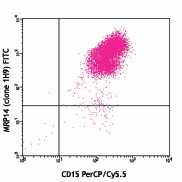
-

Human peripheral blood granulocytes surface stained with anti-human CD15-PerCP/Cy5.5, fixed and permeabilized, then intracellularly stained with anti-human MRP14-FITC (clone 1H9) (top) or mouse IgG1 FITC isotype control (middle) -

| Cat # | Size | Price | Save |
|---|---|---|---|
| 350703 | 25 tests | ¥24,640 | |
| 350704 | 100 tests | ¥55,660 |
MRP-14, also known as S100A9, belongs to the S100 family of proteins containing 2-EF-hand calcium-binding motifs. It forms non-covalently associated complexes with another S100 family member, MRP-8. MRP14 is expressed in neutrophils and monocytes; it also has been found in ileal tissue eosinophils. The S100A8/A9 complex has been shown to play a role during calcium-dependent activation as well as have antibacterial, antifungal, immunomodulating, and anti-proliferative effects. It also functions as a chemoattractant factor for neutrophils and has been considered an endogenous activator of Toll-like receptor 4. S100A9 has been identified as a marker for CD14(+) HLA-DR(-/low) MDSCs.
Product DetailsProduct Details
- Verified Reactivity
- Human
- Antibody Type
- Monoclonal
- Host Species
- Mouse
- Immunogen
- Recombinant human MRP-14
- Formulation
- Phosphate-buffered solution, pH 7.2, containing 0.09% sodium azide and BSA (origin USA)
- Preparation
- The antibody was purified by affinity chromatography, and conjugated with FITC under optimal conditions.
- Concentration
- Lot-specific (to obtain lot-specific concentration and expiration, please enter the lot number in our Certificate of Analysis online tool.)
- Storage & Handling
- The antibody solution should be stored undiluted between 2°C and 8°C, and protected from prolonged exposure to light. Do not freeze.
- Application
-
ICFC - Quality tested
- Recommended Usage
-
Each lot of this antibody is quality control tested by intracellular immunofluorescent staining with flow cytometric analysis. For flow cytometric staining, the suggested use of this reagent is 5 µl per million cells in 100 µl staining volume or 5 µl per 100 µl of whole blood.
- Excitation Laser
-
Blue Laser (488 nm)
- Application Notes
-
This clone has been published as 1H9.
Additional reported applications (for the relevant formats) include: Western blotting1 and immunohistochemical staining with paraffin-embedded tissue sections1,2. -
Application References
(PubMed link indicates BioLegend citation) -
- Robinson MJ, et al. 2002. J. Biol. Chem. 277:3658. (WB, IHC)
- Croce K, et al. 2009. Circulation 120:427. (IHC)
- Andricovich J, et al. 2016. J. Clin. Invest. 126:905. (ICFC) Pubmed
- Product Citations
-
- RRID
-
AB_10662414 (BioLegend Cat. No. 350703)
AB_10662250 (BioLegend Cat. No. 350704)
Antigen Details
- Structure
- Belongs to S100 family of proteins containing 2-EF-hand calcium -binding motifs, forms non-covalently associated complexes with another S100 family member MRP-8
- Distribution
-
MDSCs, neutrophils, monocyte, and ileal tissue eosinophils
- Function
- Calcium-dependent activation, immunomodulating and antiproliferative, endogenous activator of Toll-like receptor 4
- Interaction
- Calcium
- Cell Type
- Neutrophils, Monocytes, Eosinophils
- Biology Area
- Cell Adhesion, Cell Biology, Immunology, Innate Immunity, Signal Transduction
- Molecular Family
- Adhesion Molecules
- Antigen References
-
1. Loser K, et al. 2010. Nat. Med. 16:713.
2. Cheng P, et al. 2008. J. Exp. Med. 205:2235.
3. Leukert N, et al.2006. J. Mol. Biol. 359:961.
4. Lagasse E, et al. 1988. Mol. Cell. Biol. 8:2402.
5. Zhao F, et al. 2012. Immunology. 136:176. - Gene ID
- 6280 View all products for this Gene ID
- UniProt
- View information about MRP-14 on UniProt.org
Related Pages & Pathways
Pages
Related FAQs
Other Formats
View All MRP-14 Reagents Request Custom Conjugation| Description | Clone | Applications |
|---|---|---|
| FITC anti-human MRP-14 (S100A9) | MRP 1H9 | ICFC |
| PE anti-human MRP-14 (S100A9) | MRP 1H9 | ICFC |
| APC anti-human MRP-14 (S100A9) | MRP 1H9 | ICFC |
Customers Also Purchased
Compare Data Across All Formats
This data display is provided for general comparisons between formats.
Your actual data may vary due to variations in samples, target cells, instruments and their settings, staining conditions, and other factors.
If you need assistance with selecting the best format contact our expert technical support team.
-
FITC anti-human MRP-14 (S100A9)
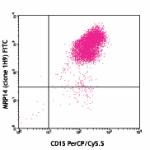
Human peripheral blood granulocytes surface stained with ant... 
-
PE anti-human MRP-14 (S100A9)

Human peripheral blood granulocytes were stained with CD15 P... 
-
APC anti-human MRP-14 (S100A9)

Human peripheral blood granulocytes were stained with CD15 P... 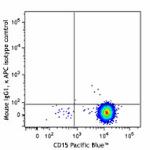









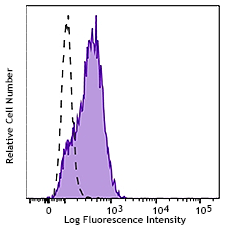
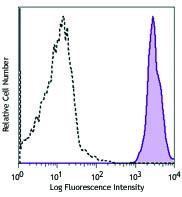
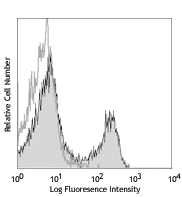




Follow Us